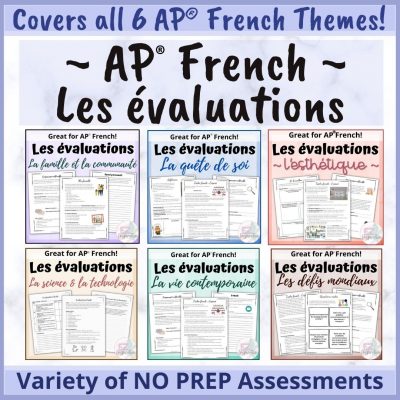
Teaching AP French is a rewarding, yet challenging experience, especially for first-time teachers. As a French teacher, you have the opportunity to shape and inspire the linguistic and cultural understanding of your students. However, preparing to teach AP French requires careful planning, familiarity with the exam format, and a deep understanding of the language and culture. In this blog post, we will explore essential tips and strategies to help you effectively prepare your students for success on the AP French exam.
1. Understanding the AP French Exam
To effectively teach AP French, it is crucial to have a clear understanding of the exam structure. Familiarize yourself with the different sections of the exam, including:
The multiple choice sections
The persuasive essay
The cultural comparison
The informal conversation
The email reply
In addition, you will want to review past exams, scoring guidelines, and sample student responses to gain insights into the expectations and grading criteria of the exam. This knowledge will enable you to provide effective exam preparation for your students and help them build the necessary skills for success.
Looking for a ready-to-go bundle that will provide the ultimate study guide for your students to conquer their AP French Exam? Check out this preparation bundle that targets all the Free Response Questions and Multiple Choice Sections of the exam. These NO PREP resources will gain you access to:
- Digital lessons
- Printable handouts
- Exam prompts
- Vocabulary lists to target all 6 themes
- Exam tips
- Exam practice and more!
2. Developing Curriculum and Lesson Plans for AP French
You will also want to create a comprehensive curriculum that aligns with the College Board’s AP French Course and Exam Description. Ensure that you cover all the required themes :
La science et la technologie – Science & Technology
Les défis mondiaux – Global Challenges
L’esthétique – Beauty & Aesthetics
La quête de soi – Personal & Public Identities
La famille et la communauté – Families in Different Societies
La vie contemporaine – Contemporary Life
By focusing on the themes, you will want to design engaging lessons that incorporate authentic resources, such as articles, videos, podcasts, and literature. Integrate cultural topics and activities to promote a deeper understanding of the francophone world. You will further want to emphasize the development of all four language skills: listening, speaking, reading, and writing throughout daily lessons and activities. It is also important that you provide ample opportunities for students to practice and engage in class discussions and other oral exchanges.
Stressed about the endless hours that you might spend planning your AP French curriculum? Check out this complete AP® French curriculum to help your students confidently complete the exam and reach their maximum potential. This 2+ year bundle allows you to gain access to a variety of comprehensive content, extensive practice materials, and skill-building activities with continuous updates. Check out the extensive preview to see what you can invest in.
**Worried about the cost? Feel free to talk to your French department head to see if your school can cover the cost of this curriculum for you or add the resource to your classroom wish list at the beginning of the school year!
3. Utilizing Authentic Resources
It is crucial that you expose your students to authentic French language materials to enhance their French proficiency and cultural knowledge. You can use a variety of resources, including news articles, podcasts, films, songs, and literary works and incorporate them into your daily lessons. Make sure that these resources are diverse and allow students to hear different accents and regional vocabulary. In doing so, you will allow students to comprehend different pronunciation variations, intonation patterns, and vocabulary nuances across different francophone regions. This exposure will also greatly help your students develop listening comprehension skills and enhance their oral proficiency while providing real-world language use.
It is also important that you encourage students to engage critically with authentic materials, analyze cultural nuances, and discuss their interpretations. These authentic resources not only improve language proficiency but also foster an appreciation for French culture and its diverse global perspectives.
4. Incorporating Test Preparation Strategies
You can also prepare your students for the specific demands of the AP French exam by incorporating test preparation strategies throughout the year. Here are a few ways that you can implement these test preparation strategies into your classroom instruction:
Practice timed multiple-choice questions to improve reading comprehension and inference skills in your classes
Focus on developing effective persuasive writing techniques, emphasizing structure, coherence, and vocabulary
Teach students how to analyze and compare cultural aspects, providing them with tools to excel in the cultural comparison section of the exam
Dedicate regular class time for oral practice, including individual presentations, group discussions, and simulated dialogues
Familiarize your students with the scoring rubrics of the exam’s free-response questions so that they understand how their performance will be evaluated
Offer constructive feedback on students’ assessments and practice exercises to help them improve their language proficiency.
Review test-taking strategies for the different components of the exam. For instance, you can provide guidance and strategies to help students approach multiple choice questions, share how to effectively analyze and respond to writing prompts, and how to manage their time during the speaking sections of the exam.
5. Monitoring Progress and Providing Feedback
You will want to regularly assess your students’ progress to identify areas of strength and areas that need improvement in their AP French journey. It is essential that you administer formative and summative assessments throughout the year, such as quizzes, essays, projects, and practice exams. After accomplishing these evaluations, you need to provide timely and constructive feedback to guide your students’ growth. You can identify common errors or misconceptions in their work and address them through targeted instruction. It is also imperative that you encourage self-reflection and self-assessment to promote independent learning and self-improvement. This process will develop their metacognition skills and allow them to become more aware of their learning processes, strategies, and goals. Their reflection will also allow them to take ownership of their learning and make informed decisions about how to enhance their understanding and skills.
Looking for authentic assessments that relate to the AP French exam themes? Check out this comprehensive bundle that offers a variety of assessments for students to choose from that target a range of assessment styles to suit your teaching style and students’ needs.
These evaluations include:
- Culminating Unit Projects
- Adapted Email Replies
- Adapted Argumentative Essay Topics
- Cultural Comparisons and more!
Conclusion
By following these essential tips, you can create an engaging and effective learning environment for your students that fosters students’ language proficiency, cultural competence, and success on the AP French exam and beyond. Ultimately, effective preparation and teaching will not only help students achieve their academic goals but also foster a lifelong passion for the French language and Francophone culture.

Advanced Placement (AP®) is a registered trademark of the College Board, which is not affiliated with, and does not endorse, this blog post.
P.S. Want to know about exciting routines that you can incorporate in your advanced class? Take a look at this blog post.



